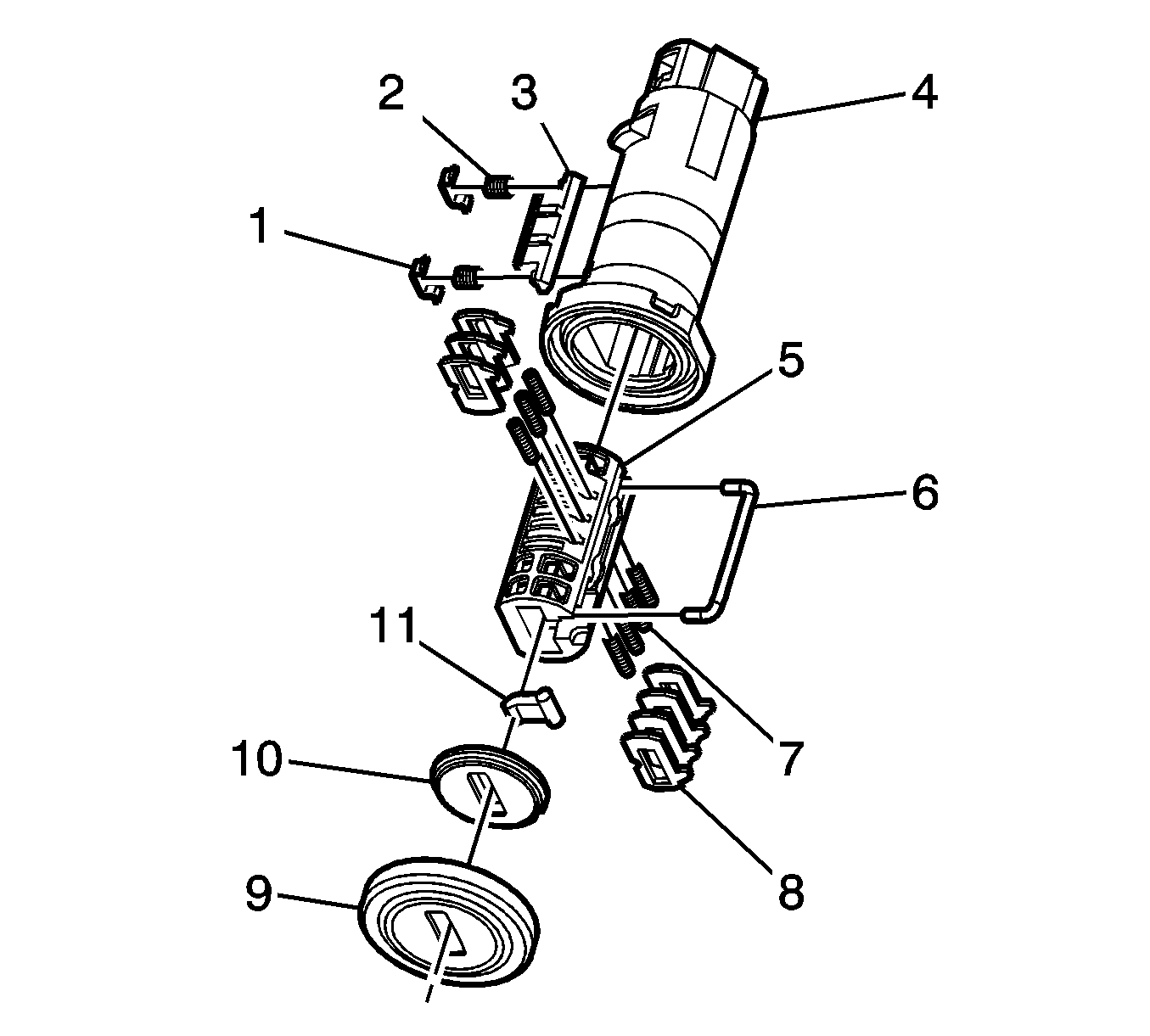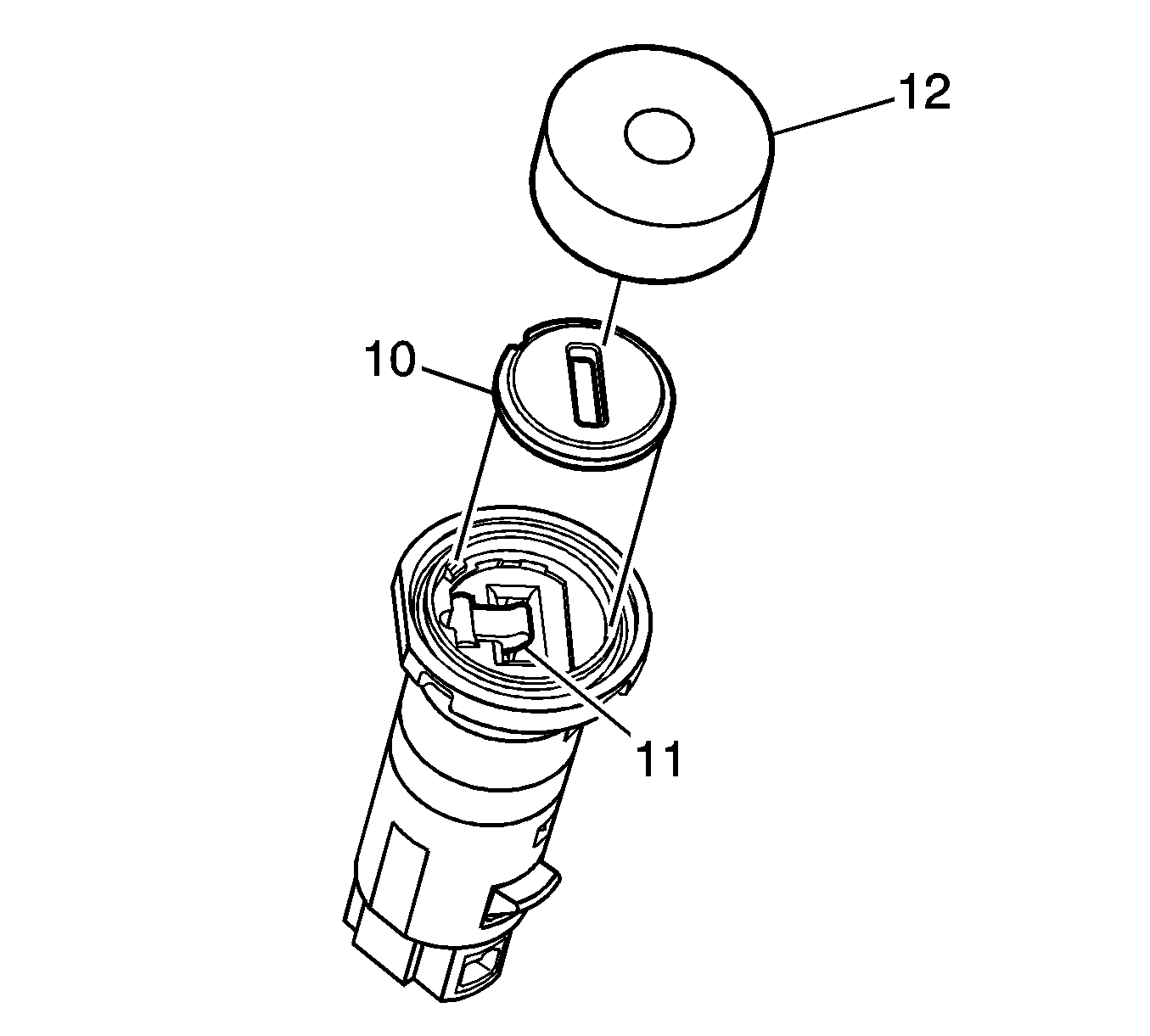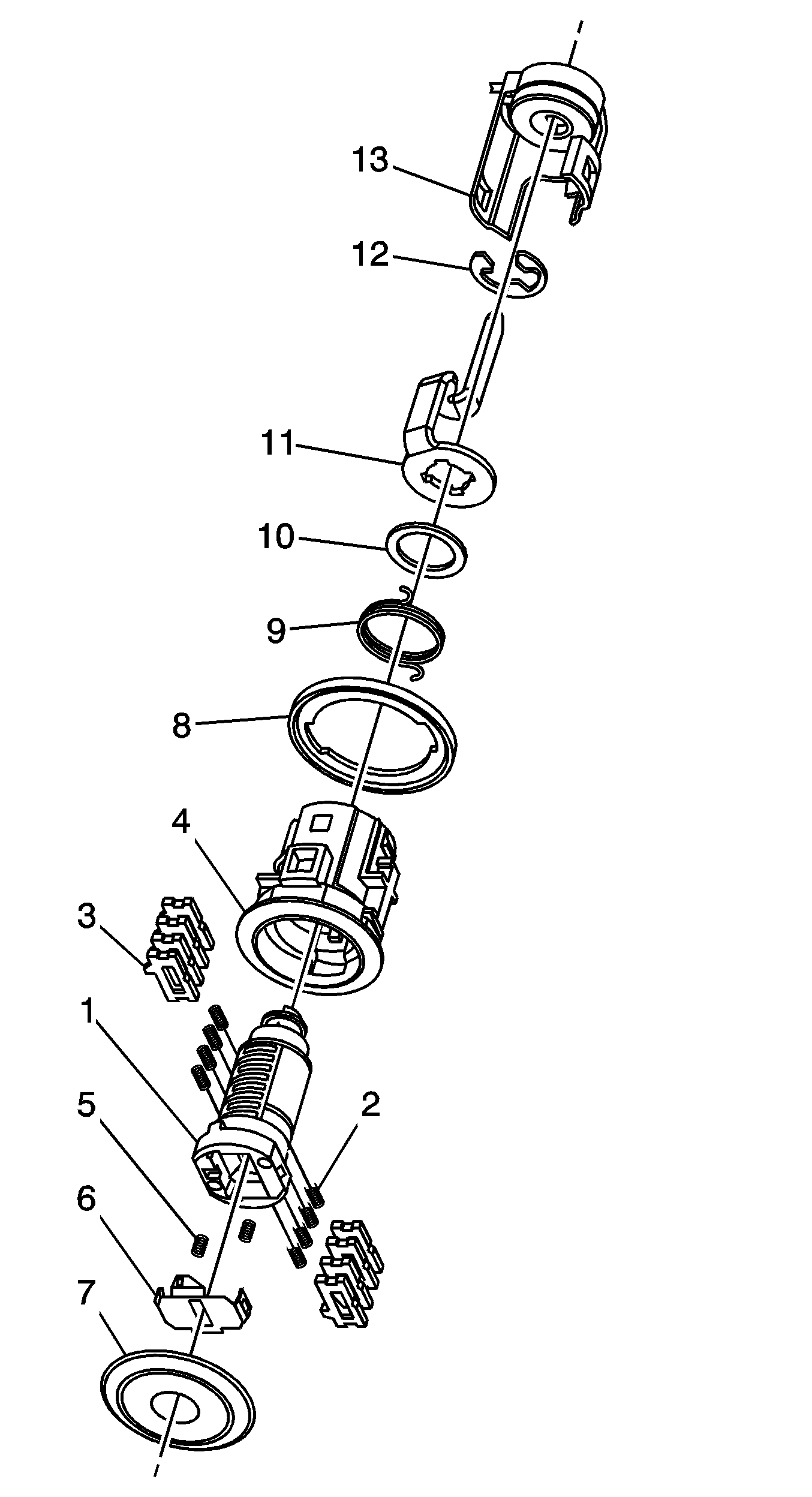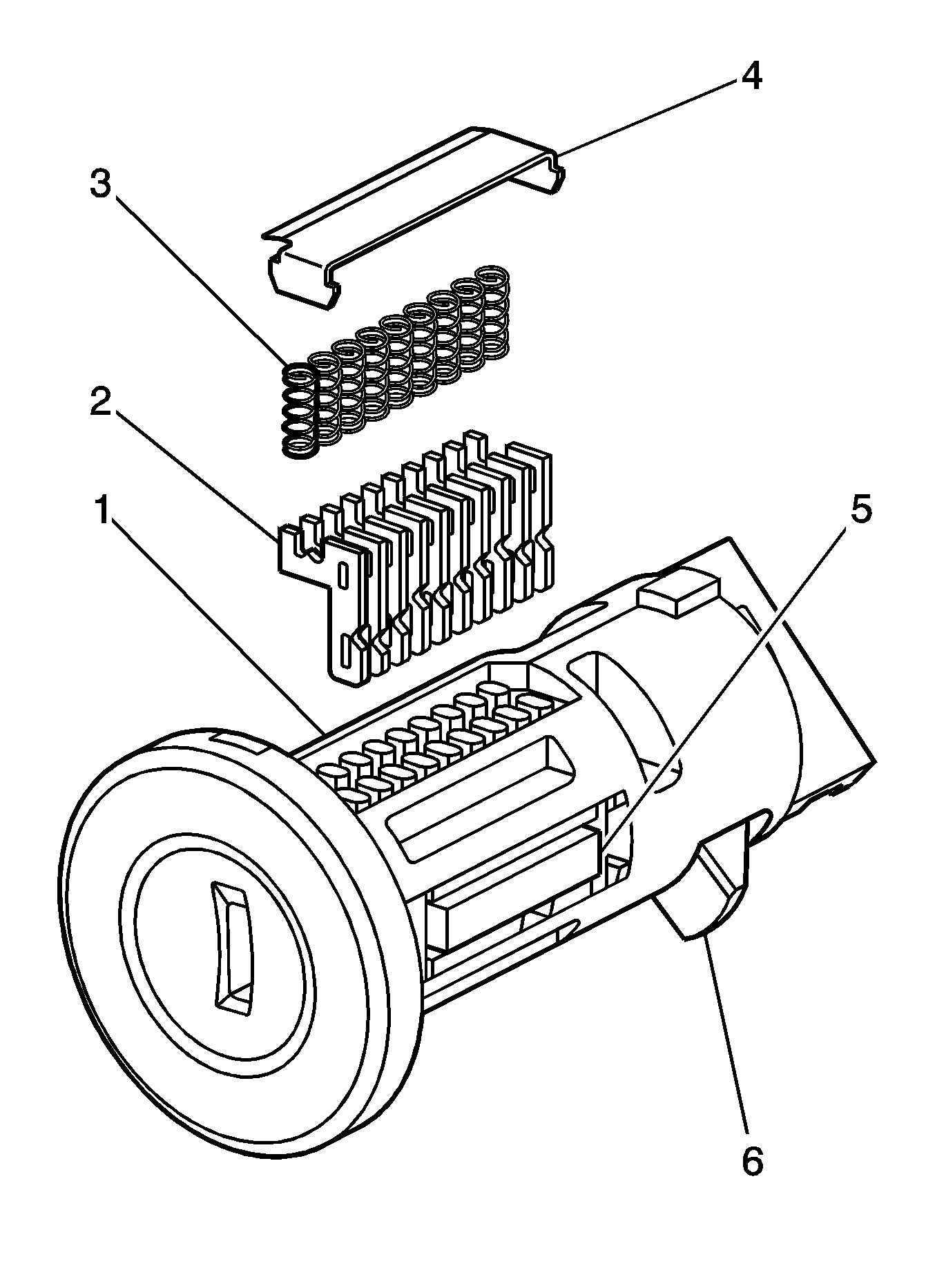Key and Lock Cylinder Coding 1st Design, Ortech
Special Tools
| • | BO-47869 Ignition Lock Cylinder Replacement Tool |
| • | BO-48370 Lock Cylinder Cap Installer |
Note: BO-47869 is used for the ignition lock cylinder. BO-48370 is used for the rear compartment lock cylinder.
Ignition Lock Cylinder
The ignition lock cylinder used 7 of the 10 key cut positions, 4-10 when counting from the key head. The tumbler (3) orientations alternate in adjacent locations from side to side with 3 on one side and 4 on the other.
- Hold the uncoded cylinder plug (5) positioned so the side with the sidebar slot is facing to the left and the 3 spring holes are on top.
- Insert one tumbler spring (7) each into the 3 tumbler spring holes.
- The first tumbler to be loaded will be key cut position number 5, the fifth number in the key code. Determine the cut depth at this position and install the corresponding tumbler (8) into the tumbler slot second from the front of the cylinder plug (5) (the end where the key is inserted).
- In the same manner, determine the cut depth and corresponding tumbler and install the 2 remaining tumblers (8) into the tumbler slots located at key cut positions 7 and 9.
- Check for correct loading by holding the tumblers (8) in position and fully inserting the matching key into the cylinder plug (5). All tumblers should be flush with the outside diameter of the cylinder plug.
- Rotate the cylinder plug (5) so that the side with the sidebar slot is facing to the right and then remove the matching key. Remember the tumblers (8) are not self-retaining and must be held in place.
- Insert one tumbler spring (7) each into the 4 tumbler spring holes.
- The first tumbler to be loaded will be key cut position number 4. Determine the cut depth at this position and install the corresponding tumbler (8) into the tumbler slot nearest the front of the cylinder plug (5).
- In the same manner, determine the cut depth and corresponding tumbler and install the 3 remaining tumblers (8) into the slots located at key cut positions 6, 8, and 10.
- Check for correct loading by holding the tumblers (8) in position and fully inserting the matching key into the cylinder plug assembly (5). All tumblers should be flush with the outside diameter of the cylinder plug.
- Lightly lubricate tumbler (8) surfaces using the lubrication provided.
- Hold the cylinder plug (5) positioned so the side with the sidebar slot is facing to the left. Insert the U-shaped plunger shaft (6) into the grooves on the right side of the cylinder plug.
- Install the cylinder plug assembly (5) into the cylinder sleeve assembly (4). There is a slight interference fit between the cylinder plug and the cylinder sleeve assembly, so be sure that the cylinder plug is fully seated into the bottom of the cylinder sleeve. The cylinder plug should be slightly below flush with the inner face of the cylinder sleeve. Once the cylinder plug assembly is fully installed into the cylinder sleeve assembly, the tumblers (8) will be fully enclosed and retained.
- Install the actuator (11) into the pocket in the front face of the cylinder plug.
- Install the security plate (10) on top of the cylinder plug in the cylinder sleeve assembly.
- Securely stake the security plate (10) into the cylinder sleeve assembly (4) by using the BO-47869 . Assemble the cylinder sleeve assembly, security plate, and BO-47869 . When loading cylinder sleeve assembly into the staking tool, ensure staking cup number 12 is positioned cup toward cylinder sleeve. Secure assembled staking tool in a vise. Rotate the forcing screw (13) in order to uniformly stake the cylinder sleeve material over the security plate.
- Install and stake the cover (9) onto the head of the cylinder sleeve assembly (4) by crimping the cover material in 4 places into the pockets around the head of the cylinder sleeve. Ensure the cover is securely held onto the cylinder sleeve and that the key can be inserted into the cylinder sleeve assembly through the slot in the cover.
- Install the sidebar (3) into the cylinder sleeve assembly (4).
- Install the 2 sidebar springs (2) into the cylinder sleeve assembly (4).
- Install the stake and the 2 sidebar spring retainers (1) onto the cylinder sleeve assembly (4) by crimping the material on the cylinder sleeve onto the sidebar spring retainers. Ensure the sidebar spring retainers are securely attached to the cylinder sleeve.
- Insert the matching key into the cylinder assembly and confirm the following:
- Install the ignition cylinder assembly into the steering column of the vehicle

Warning: Wear safety glasses in order to avoid eye damage.
Note: The ignition lock cylinder tumblers (3) are not self-retaining and must be held in place if the key is not fully inserted into the lock cylinder.

Caution: Refer to Fastener Caution in the Preface section.

Tighten
Tighten the forcing screw (13) to 23-28 N·m (17-21 lb ft). Once the security plate has been staked to the assembly, ensure the actuator (11) can rotate freely inside the assembly
by inserting a key and removing it.

| 21.1. | The sidebar drops to be flush or below flush with the outer diameter of the cylinder sleeve (4) when the matching key is fully inserted into the cylinder assembly. |
| 21.2. | The sidebar protrudes out of the diameter of the cylinder sleeve when the matching key is removed from the cylinder assembly. |
| 21.3. | With the matching keys installed, the plunger protrudes to be flush or almost flush with the rear of the cylinder sleeve. |
Rear Compartment Lid Lock Cylinder
The rear compartment lid lock cylinder uses 8 of the 10 key cut positions, 3-10 when counting from the key head. The tumbler orientations alternate in adjacent locations from side to side with 4 on each side.
- Hold the uncoded cylinder (1) positioned so the side with the drain hole is facing downward.
- Insert one tumbler spring (2) each into the 4 tumbler spring holes.
- The first tumbler to be loaded will be key cut position number 3, the third number in the key code. Determine the cut depth at this position and install the corresponding tumbler (3) into the tumbler slot nearest the front of the cylinder (1), the end where the key is inserted.
- In the same manner, determine the cut depth and corresponding tumbler and install the 3 remaining tumblers (3) into the tumbler slots located at key cut positions 5, 7, and 9.
- Check for correct loading by holding the tumblers (3) in position and fully inserting the matching key into the cylinder (1). All tumblers should be flush with the outside diameter of the cylinder.
- Rotate the cylinder (1) so that the side with the drain hole is facing upward and then remove the matching key. Remember the tumblers (3) are not self-retaining and must be held in place.
- Insert one tumbler spring (2) each into the 4 tumbler spring holes.
- The first tumbler to be loaded will be key cut position number 4. Determine the cut depth at this position and install the corresponding tumbler (3) into the open tumbler slot nearest the front of the cylinder.
- In the same manner, determine the cut depth and corresponding tumbler and install the 3 remaining tumblers into the tumbler slots located at key cut positions 6, 8, and 10.
- Check for correct loading by holding the tumblers (3) in position and fully inserting the matching key into the cylinder (1). All tumblers should be flush with the outside diameter of the cylinder.
- Lightly lubricate tumbler (3) surfaces using the lubrication provided.
- With the matching key fully inserted into the coded cylinder, install the coded cylinder into the case (4).
- Remove the matching key being careful to keep the coded cylinder (1) fully inserted into the case (4).
- Insert one shutter spring (5) each into the 2 shutter spring holes located on the front face of the cylinder (1).
- Install the shutter assembly (6) into the recessed area on the front face of the cylinder (1). Be sure that the ends of the pin on the shutter assembly are positioned in the pin cavities located in the front face of the cylinder.
- Stake the cap (7) onto the head of the case (4) by using the appropriate staking tool BO-48370 (a). Ensure proper orientation and set the cylinder assembly (14) (b), which includes the case (4), coded cylinder (1), shutter springs (5), and shutter assembly (6)) and the cap (7) into the staking cup (15) and clamp into vise. Remove any debris and install the cleaned staking ram (16) into staking cup (15) and with a dead blow hammer, hit the staking ram (16) with moderate force 2 or 3 times. Check to determine if cap is securely staked to the cylinder assembly (14) (b). Repeat previous step until cap is securely staked to the cylinder assembly 14 (b). Remove assembly from the staking cup (15). If necessary, insert the removal punch (17) into the opposite end of the staking cup and tap lightly. Confirm that the shutter springs (5) push the shutter assembly (6) up against the inside surface of the cap (7).
- Install the gasket (8) over the end of the cylinder assembly and slide it all the way up the case (4) until it seats behind the cap (7).
- Install the return spring (9) over the back end of the cylinder (1) with the straight hook facing the rear of the case (4). Engage the straight hook of the return spring with the hook feature on the rear of the case.
- Install the spacer (10) and lever (11) onto the end of the cylinder (1).
- Install the retaining ring (12) in the groove at the end of the cylinder (1) to secure the lever (11) to the cylinder. Engage the bent hook of the return spring (9) with the lever.
- Install the theft deterrent switch (13) onto the end of the cylinder (1) and snap the switch legs onto the case (4). Be sure the theft deterrent switch is engaged with the end of the cylinder and is securely attached to the case.
- Check the operation of the lock assembly. The return spring (9) should provide a counterclockwise snap back.

Note: The rear compartment lid lock cylinder tumblers (3) are not self-retaining and must be held in place if the key is not fully inserted into the lock cylinder or until the cylinder (1) is assembled into the case (4).

Note: Be careful not to scratch or dent the cosmetic surface of the cap or damage the lock cylinder in any way while staking the cap.

Key and Lock Cylinder Coding 2nd Design, Strattec
Special Tools
BO-48370 Lock Cylinder Cap Installer
Ignition Lock Cylinder

The ignition lock cylinder uses only 9 of the 10 cut positions, 2-9. The ignition cylinder tumblers (2) are all located on one side of the cylinder (1) and not self-retaining. A retainer (4) secures the tumblers. It follows the key code with the first tumbler being the first depth of the key code.
- Hold the ignition cylinder (1) so that the side with the tumbler spring wells is facing up.
- The first tumbler (2) to be loaded will be the second key cut position, the second number in the key code. Install the first tumbler in the slot nearest the head of the lock cylinder. Install the remaining tumblers following the key code.
- Insert tumbler springs (3) into the wells on top of the tumblers.
- Assemble the retainer (4) over springs. Secure by moving cylinder material over edges of the retainer with a center punch on each of the four corners over the ends of the retainer.
- Inspect for correct loading of the tumblers by inserting the key into the cylinder. The side bar (5) should drop flush with the lock cylinder body diameter.
- Lightly lubricate the outside surfaces in the tumbler area of the lock body and down the key slot using the supplied grease. Insert and extract the key 5 times to lubricate the keyway.
- Line-up the lock to the run position. Insert lock in steering column making sure the retainer (6) is seated properly. Rotate lock to key out position and remove the key. Insert the key and rotate the lock 3 times to distribute the grease from the lock to column housing inside diameter.
Rear Compartment Lid Lock Cylinder

The rear compartment lid lock cylinder uses 8 of the 10 key cut positions, 3-10 when counting from the key head. The tumbler orientations alternate in adjacent locations from side to side with 4 on each side.
- Hold the uncoded cylinder (1) positioned so the side with the drain hole is facing downward.
- Insert one tumbler spring (2) each into the 4 tumbler spring holes.
- The first tumbler to be loaded will be key cut position number 3, the third number in the key code. Determine the cut depth at this position and install the corresponding tumbler (3) into the tumbler slot nearest the front of the cylinder (1), the end where the key is inserted.
- In the same manner, determine the cut depth and corresponding tumbler and install the 3 remaining tumblers (3) into the tumbler slots located at key cut positions 5, 7, and 9.
- Check for correct loading by holding the tumblers (3) in position and fully inserting the matching key into the cylinder (1). All tumblers should be flush with the outside diameter of the cylinder.
- Rotate the cylinder (1) so that the side with the drain hole is facing upward and then remove the matching key. Remember the tumblers (3) are not self-retaining and must be held in place.
- Insert one tumbler spring (2) each into the 4 tumbler spring holes.
- The first tumbler to be loaded will be key cut position number 4. Determine the cut depth at this position and install the corresponding tumbler (3) into the open tumbler slot nearest the front of the cylinder.
- In the same manner, determine the cut depth and corresponding tumbler and install the 3 remaining tumblers into the tumbler slots located at key cut positions 6, 8, and 10.
- Check for correct loading by holding the tumblers (3) in position and fully inserting the matching key into the cylinder (1). All tumblers should be flush with the outside diameter of the cylinder.
- Lightly lubricate tumbler (3) surfaces using the lubrication provided.
- With the matching key fully inserted into the coded cylinder, install the coded cylinder into the case (4).
- Remove the matching key being careful to keep the coded cylinder (1) fully inserted into the case (4).
- Insert one shutter spring (5) each into the 2 shutter spring holes located on the front face of the cylinder (1).
- Install the shutter assembly (6) into the recessed area on the front face of the cylinder (1). Be sure that the ends of the pin on the shutter assembly are positioned in the pin cavities located in the front face of the cylinder.
- Stake the cap (7) onto the head of the case (4) by using the appropriate staking tool BO-48370 (a). Ensure proper orientation and set the cylinder assembly (14) (b), which includes the case (4), coded cylinder (1), shutter springs (5), and shutter assembly (6)) and the cap (7) into the staking cup (15) and clamp into vise. Remove any debris and install the cleaned staking ram (16) into staking cup (15) and with a dead blow hammer, hit the staking ram (16) with moderate force 2 or 3 times. Check to determine if cap is securely staked to the cylinder assembly (14) (b). Repeat previous step until cap is securely staked to the cylinder assembly. Remove assembly from the staking cup (15). If necessary, insert the removal punch (17) into the opposite end of the staking cup and tap lightly. Confirm that the shutter springs (5) push the shutter assembly (6) up against the inside surface of the cap (7).
- Install the gasket (8) over the end of the cylinder assembly and slide it all the way up the case (4) until it seats behind the cap (7).
- Install the return spring (9) over the back end of the cylinder (1) with the straight hook facing the rear of the case (4). Engage the straight hook of the return spring with the hook feature on the rear of the case.
- Install the spacer (10) and lever (11) onto the end of the cylinder (1).
- Install the retaining ring (12) in the groove at the end of the cylinder (1) to secure the lever (11) to the cylinder. Engage the bent hook of the return spring (9) with the lever.
- Install the theft deterrent switch (13) onto the end of the cylinder (1) and snap the switch legs onto the case (4). Be sure the theft deterrent switch is engaged with the end of the cylinder and is securely attached to the case.
- Check the operation of the lock assembly. The return spring (9) should provide a counterclockwise snap back.
Note: The rear compartment lid lock cylinder tumblers (3) are not self-retaining and must be held in place if the key is not fully inserted into the lock cylinder or until the cylinder (1) is assembled into the case (4).

Note: Be careful not to scratch or dent the cosmetic surface of the cap or damage the lock cylinder in any way while staking the cap.

